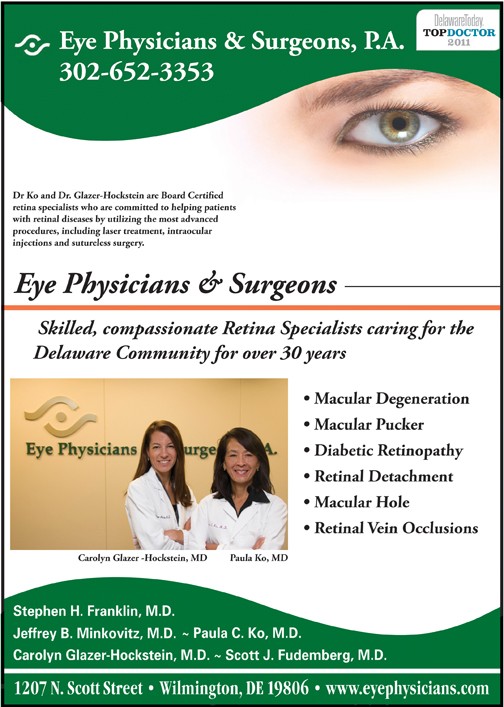Flashes And Floaters – Symptoms Of Possible Retinal Tear Or Detachment
By Dr. Paula Ko
Think of the eye like a camera; it is a very small organ with many different parts to it. The eye has a lens that focuses the light on the retina.
The retina is like the film of a camera – it lines the back wall of the eye similar to wallpaper. When a patient complains of flashes and floaters, as a retina specialist I am always concerned about problems with retinal tears and/or detachments. The retina can tear or detach and the initial symptoms may start as flashes and floaters. If the retina starts to detach, then a patient may notice a dark shadow or shade that descends over their vision. If left untreated, a patient will go blind.
Floaters are a common symptom that many patients may experience. Typically floaters are dark, small, and float back and forth. Many times floaters get in the way of vision, but if the eye looks back and forth, the floater can float out of the way. Acute floaters can occasionally be harmless however more commonly acute floaters are a symptom of something more serious. If one has had floaters for many years and they have not gotten worse, then usually it is nothing to worry about. If one experiences floaters acutely, and they have not experienced them before, it usually signifies a problem. The only real way to tell the difference is to get a complete eye examination including dilation, allowing the entire retina to be checked. If a tear develops, many times it is in the periphery of the retina which can not be seen unless the pupil is dilated. If a patient complains of new floaters in one eye and the floaters do not go away she/he should be seen immediately.
Flashes are not as common and are typically associated with floaters. Flashes that are caused by a retinal tear or detachment usually occur in the periphery of the vision (side vision) and are noted at night or in the dark, usually lasting for less than a second. They can occur frequently but the actual flash lasts for a very short period of time. Flashes can also be induced when one looks quickly from side to side.
The most common cause of flashes and floaters is a posterior vitreous detachment (PVD). This occurs as a normal aging process. The process usually begins by age 50, and by age 70 more than 50% of people have had a PVD. The back inside cavity of the eye is filled with vitreous fluid. When you are born, the fluid is clear and gelatinous, like egg white before it is cooked. As one ages, the vitreous starts to liquefy. As it liquefies, the vitreous starts to contract and pull away from the retina. When it pulls away, the vitreous tugs on the retina and causes flashes – the retina is stimulated by the vitreous tugging on the retina. When a PVD occurs, patients will commonly notice flashes and floaters. It is usually during this 6-8 week period of the vitreous pulling away from the retina that a patient is at risk for retinal tears or detachments. Sometimes when the vitreous jelly is pulling loose, it will cause a tear or a retinal detachment. If a retinal tear goes untreated it commonly will lead to a retinal detachment. The initial symptoms of a PVD should be checked out immediately.
A retinal tear is much easier to treat (requires laser in the office) than a retinal detachment (requires more involved surgery). Hence, catching a problem earlier and before vision loss is always better.
While a PVD usually occurs spontaneously, it can also be caused by blunt trauma to the eye or a hard hit to the back of the head that causes secondary injury to the eye.
In summary, acute flashes and floaters should always be checked out with a dilated eye exam immediately, usually within
1–2 days from when they start. The most common cause is a PVD, which causes very little damage, but a tear or retinal detachment may be the cause and immediate treatment may be needed.
Dr. Carolyn Glazer-Hockstein and Dr. Paula Ko are retina specialists at Eye Physicians and Surgeons who are committed to helping patients with AMD and other retinal diseases. If you would like to learn more about AMD or to schedule an appointment call (302) 652-3353.
Dr. Glazer-Hockstein graduated Cum Laude from Jefferson Medical College. She was a member of the Hobart Armory Hare Honor Medical Society and was elected to the Alpha Omega Alpha Honor Society. She also received the Carol R. Mullen prize in ophthalmology. She completed her residency at the Scheie Eye Institute, University of Pennsylvania. During that time she was elected Chief Resident. After residency, Dr. Glazer-Hockstein completed a two years medical retina fellowship at the Scheie Eye Institute, University
of Pennsylvania.
Dr. Glazer-Hockstein has published multiple articles in peer-review journals and has lectured on a variety of retinal disease subjects. Her specialization includes but is not limited to: macular degeneration, retinal vascular disease, and diabetic retinopathy.
Paula C. Ko, MD is with Eye Physicians & Surgeons, P.A., 1207 North Scott Street, Wilmington, DE 19806. Dr. Ko graduated with honors from the Ohio State University College of Engineering in 1984. Dr. Ko received her M.D. degree from the Ohio State University College of Medicine in 1989, again with honors. Following her residency in Ophthalmology at Temple, Dr. Ko served a prestigious fellowship at Georgetown University in diseases of the retina and vitreous, and is Certified by the American Board of Ophthalmology.
Dr. Ko has an area of special expertise in retinal problems, especially diabetic eye disease, macular degeneration, retinal detachment, and CMV retinitis. Dr. Ko has lectured extensively, and has published many papers on these topics. Dr. Ko is active in resident training, and is on staff at the University of MD and Temple University, as well as at the Medical Center of DE. Dr. Ko is at the forefront of ophthalmic technology, and utilizes the most advanced procedures, including laser treatment and intraocular injections, in the care of her patients.



